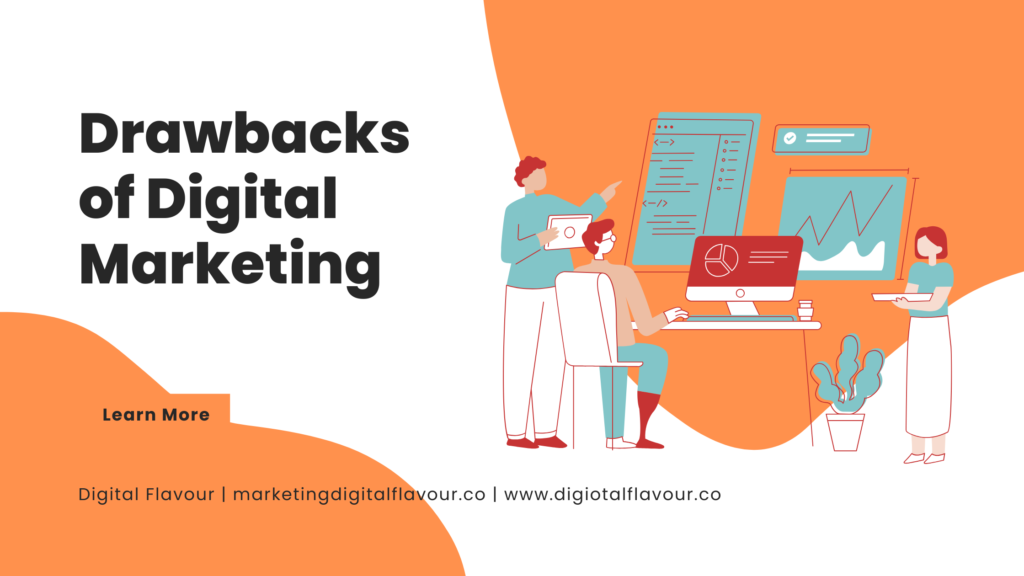As digital marketing has grown, it is rapidly becoming the new approach that virtually all businesses will turn to for quick targeting of potential clientele. The digital space includes a variety of forms, ranging from social media campaigns to email newsletters to the list goes on. But is just about every business case true about digital marketing?
It does hold certain global benefits for reaching, along with measurability of results, and also cost-effectiveness with its campaigns, it surely has flipside disadvantages. Many businesses like to leap on to digital without having an idea about what are the challenges due to which there is wastage of budgets, missed opportunities, and in some cases even reputational loss.
In this blog, Digital Flavour, Best Digital Marketing Agency will talk about the downsides of digital marketing and why it is important to see beyond the various hype all around. So, whether you are a business owner looking for the next marketing move or someone just interested in learning about the digital space, this blog would serve as your guide through what really is not talked about normally in online marketing and keep you prepared to make smarter decisions.
Now, let’s get into the weaker side of it that you need to consider before diving into the pool of digital marketing.
Table of Contents
ToggleAdvantages of Digital Marketing
Before examining the drawbacks of digital marketing, it is essential to recognize its significance as a fundamental component of contemporary business strategies. This prominence is not arbitrary; it stems from concrete advantages that can fundamentally change how businesses engage with their target audiences. Let us take a moment to highlight these benefits of digital marketing.
1. Global Reach and Accessibility
Digital marketing enables companies to establish connections with consumers worldwide at the touch of a button. Whether operating as a neighborhood bakery or an international conglomerate, platforms such as Google Ads and social media facilitate access to extensive audiences without geographical constraints. For instance, a small e-commerce enterprise based in India can easily reach customers in the United States thanks to available digital solutions.
2. Cost-Effectiveness
In contrast to traditional forms of advertising like television and print ads, digital marketing proves to be considerably more economical. Small enterprises with restricted budgets can conduct specific campaigns for minimal investment while ensuring their messages are conveyed effectively to their desired audience. Tools like pay-per-click (PPC) advertising allow businesses to manage expenditures by paying solely for actual interactions.
3. Targeted Marketing and Personalization
A significant advantage of digital marketing lies in its capacity for precision targeting based on data analysis. Platforms such as Facebook and Google empower brands to narrow down their audience according to criteria like age, location, interests, and behaviors. Additionally, personalization functions permit companies to produce customized messages that make each advertisement or email feel relevant and engaging.
4. Measurable Results
Unlike conventional methods that often lack clarity regarding effectiveness, digital marketing provides comprehensive analytics allowing businesses to monitor campaign performance almost instantaneously. Tools like Google Analytics offer valuable insights into website traffic trends, conversion rates, and user activity patterns—enabling organizations to refine their strategies efficiently.
5. Boosted Customer Engagement
Thanks to social media, brands now get to go one-on-one with their audience. Be it through comments, polls, or live streams, Instagram and Twitter foster two-way communication that creates trustworthiness and loyalty.
6. Flexibility Across Channels
With search engine optimization (SEO), content marketing, video advertising, and email campaigns, digital marketing has a splash of channels to test. A business can use different ways of approach, observe what are their best options, and pivot on-demand—all without being tied to a fixed commitment.
While these benefits make digital marketing an essential ingredient for businesses, they also enact the flip-side of it. For instance, the same platform that offers a bearer for worldwide reach also has the potential of ushering in severe competition. In a similar vein, personalized campaigns depend on data as far as concerns of privacy are concerned.
As we move forward, let’s take a look at the disadvantages of digital marketing and understand why it isn’t always a perfect option.
Disadvantages of Digital Marketing
While digital marketing has merits in growing businesses and customer engagement, it has other downsides that should not be ignored. Here are some of the most relevant disadvantages of digital marketing that a business owner should assess before taking the plunge.
1. Tremendous Competition
Digital marketing is accessible to everyone and thus has heightened competition. From start-ups to corporations, every business operates intensely online. Therefore, small-scale ventures find it difficult to make their mark.
- Expensive Ads in Competitive Niches: In sectors like technology or e-commerce, the cost-per-click (CPC) on Google Ads can skyrocket and give diminishing returns for businesses with low budgets.
- Continued to push online itself: Millions of brands are posting updates and the organic reach on Facebook and Instagram declines, forcing businesses to spend immensely on paid promotions.
Pro Tip: Build a strong value proposition and create ultra-focused campaigns catered to a specific niche audience-this will help.
2. Overdependence on Technology
Electronic Marketing is predominantly ruled by technology, and therein lies the danger and challenges.
- Platform Dependence: Companies relying heavily on certain platforms (Facebook, Google) are surely threatened by their algorithms. A sudden wonderful update could mean less visibility and an even lessened traffic number.
- Technical Issues: Downtime on servers, software glitches, or even slow internet may undercut campaigns, missing opportunities with both cost and agency.
- The Learning Curve: Having to perpetually be trained on, linked with, and updated on the latest tools, trends, and software implies a constant engagement with development resources.
3. Privacy and Data Security Concerns
Data dependence for targeted marketing has ushered in an era of visible privacy concerns in the digital sphere.
- Compliance Difficulties: Legislation such as GDPR (General Data Protection Regulation) and CCPA (California Consumer Privacy Act) require strict handling of user data. Non-compliance can incur huge penalties.
- Trust Erosion: Incidents like data breaches and annoying ads only dent consumer trust. For instance, very aggressive retargeting can be frustrating to users without converting them.
Pro Tip: Invest in good cybersecurity, stay transparent, and let your consumers know how you collect and use data about them.
4. High Skill Requirement
Digital marketing seems easy, yet running successful campaigns needs expertise in different areas, such as:
- SEO: Always trying to keep pace with algorithm changes.
- Analytics: Understanding the data and making decisions accordingly.
- Content Creation: Consistently producing engaging content valuable to the consumer.
Many businesses are not capable enough to manage all of these aspects internally, which will put them into hiring agencies or professions at extra costs.
5. Short Content Lifespan
In a digital landscape that whirls at a dizzying pace, content can be rendered irrelevant.
- Social Media Trends: Viral posts are in and out overnight; hence, they require constant creation of new content to keep audience engagement levels steady.
- Ad Fatigue: Repeated ad exposure may trigger low click-through rates and conversions.
Pro Tip: Develop an evergreen content strategy that juggles trending topics along with evergreen resources, like guides or tutorials.
6. Risk of Poor Targeting
Though the digital marketing industry is quite excellent at targeting distinct audience segments, errors in segmentation or excessive reliance on automation could easily result in ineffective campaigns.
- Bad Data: Erroneous analytics, bad customer profiling, or customer records that haven’t seen an update in quite a while may throw resources into the arms of the wrong audience.
- Over-Automation: In too much dependence on AI, campaigns may take on a sterile look that discourages customer interaction.
Pro Tip: Conduct frequent audits of your audience segments and attempt to marry automation with human supervision for retaining that personal touch.
Disadvantages of digital marketing do not call for throwing it altogether. Rather, they must indicate the requirement for a strategic and balanced approach. In the next section, we will delve into common situations where digital marketing could not work and options for ameliorating its weaknesses.
When Digital Marketing Might Not Work
Digital marketing has influenced how businesses engage with their audience, but it cannot be a true catch-all. There are specific situations and circumstances making it less effective, and knowing such scenarios can put businesses in a better place to make more intelligent marketing calls.
1. Niche or Local Businesses with Limited Digital Presence
The global reach of digital marketing is astonishing, yet all local businesses that rely on foot traffic or word-of-mouth referrals may not see a proportional return on investment from digital channels.
- Example: A small-town bakery may find more benefit from community events or ads in the local newspaper than competing in crowded digital environments.
- Challenge: Digital advertisements may overshoot the allocation for targeting an immediate neighborhood audience with much-reduced returns.
Alternative: Double down on local SEO and Google My Business but support this with traditional promotional efforts such as flyers or partnering with local businesses.
2. Businesses Targeting Non-Digital Audiences
Some audiences are not active online. Older generations or communities in underdeveloped regions for internet access may not respond to digital campaigns.
- Example: Healthcare services targeting senior citizens may realize greater strides through mail shipments, phone calls, or television ads.
- Challenge: Focusing a marketing campaign entirely on the digital sphere can lead to missing prominent demographics.
Alternative: A hybrid way by furthering electronic channels with traditional platforms such as radio, print, or local outreach.
3. Industries Where Trust Takes Time
Digital marketing can hardly suffice for these high-ticket industries that need a more sustained trust built up over time, such as real estate or healthcare or laws.
- Example: An online law firm cannot gain the much-needed credibility if no client testimonies or no local recognition exist.
- Challenge: Digital ads tend to feel impersonal, thus making it harder to build the kind of trust necessary to make big purchases.
Alternative: Applies the trusted digital marketing along with networking in person and seminars and community work to build that credibility and trust.
4. Limited Budget for Competitive Niches
In saturated industries like e-commerce or tech, the cost of advertising or branding can be too high for small businesses to work with.
- Example: A tech gadget startup might have a rough time competing with established giants like Amazon or Apple in paid advertising.
- Challenge: To outbid or stand out against entrenched competitors requires a huge amount of investment in search ads.
Alternative: Focus on cultivation, organic marketing, like content, SEO, and influencer partnerships, to build a loyal customer base with no excess dollars.
5. Inconsistent or Poor Execution
Digital marketing is as good as the execution. Poorly designed campaigns, mixed messaging, and no strategizing could lead to a waste of resources.
- Example: A business investing in social media ads without targeting or any attention-grabbing creatives might not see engagement and returns.
- Challenge: Businesses often opt for digital marketing without a roadmap or individuals skilled enough to manage it.
Alternative: Hire experienced marketers or agencies, and bring campaigns based on planning and data analytics, leaving ad hoc efforts behind.
We have already covered the areas in which digital marketing is inadequate; now it is best to address how businesses can overcome these difficulties. Our next section will include practical tips on how to deal with some challenges of digital marketing and evolve into a more balanced marketing strategy.
How to Mitigate the Disadvantages of Digital Marketing
Of course, knowing what challenges digital marketing faces is only the first step; the next step is to take the time to know how to effectively overcome these challenges and help their company succeed directly against their competitors. Some concrete methods for countering the weaknesses of digital marketing are mentioned.
1. Develop a Diversified Marketing Strategy
Do not rely solely on digital marketing. Having a good hybrid strategy helps you in reaching a number of different segments of your audience.
- Trivia fact: This is a Northern marketing strategy combining digital campaigns and traditional marketing methods such as direct mail, event sponsorships, or in-store promotions.
- Benefit: Businesses can connect with audiences that may not engage online in this manner.
2. Focus on Audience Research and Targeting
The target audience is the backbone of any good marketing plan. Put in the time it takes to learn whom you’re talking to, including their preferences, pain points, and online behaviors.
- How to Implement:
- Use Google Analytics, Facebook Audience Insights, and customer surveys.
- Keep refining your audience segments on an ongoing basis to remain accurate.
- Benefit: Targeted messaging cuts dow on wasted ad spends and builds engagement rates.
3. Invest in Quality Content Creation
To survive the competition and keep audiences engaged, it makes sense to pursue the goal of creating good quality, relevant, and handing out content on a continuous basis.
- Content Types:
- Blog posts and how-to guides (evergreen content)
- Interactive content: quizzes, polls, and webinars.
- Videos and infographics, for visual appeal.
- Benefit: Quality content grants authority and keeps your brand on the consumer’s mind even in the dense digital space.
4. Staying Updated on Trends in Technology
The basic thing to note in the type of industry we are covering in digital marketing is that it’s changing fast. Any business that seeks to thrive needs to be updated as far as algorithm changes, newest tools, and emerging platforms are concerned.
- Staying Current:
- Attend webinars and conferences in your industry.
- Check trusted marketing blogs such as HubSpot, Neil Patel, and Search Engine Journal.
- Try new social features: Instagram Reels, YouTube Shorts, etc.
- Benefits: Being on top of trends keeps the campaigns from becoming idle and never effective.
5. Prioritize Data Privacy and Security
Respecting the privacy of users cultivates trust while reducing the risk of being sued.
- Best Practices:
- Clearly specify your privacy policy and follow regulations such as the GDPR and CCPA.
- Use secure payment gateways and encrypt sensitive information.
- Limit data collection to what is needed for your campaigns.
- Advantage: Transparent data practices build consumer trust and loyalty.
6. Allocate Budget Wisely
Channel your spending towards channels that promise the highest ROI.
- Tips:
- Start A/B ad tests to see what works best.
- Use automation tools such as HubSpot or ActiveCampaign to minimize hand work and thus costs.
- Track metrics such as Cost Per Lead (CPL) and Customer Acquisition Cost (CAC).
- Benefit: Smart budget allocation allows you to accrue the highest return on your investments.
7. Balance Automation with Personalization
A degree of automation can save time; however, overdoing it may render campaigns less personable.
- How to Balance:
- Email automation is a good example; but personalize both subject lines and content based on what users do.
- Give interactive replies to followers’ comments and direct messages on social media.
- Benefit: Upon users personally experiencing personalization, interactions increase and thus conversions rise too.
While minimizing the usual drawbacks of digital marketing is crucial, determining when it is not suitable for business goals is equally important. In the next section, we will discuss the instances when businesses should consider alternative marketing strategies and how for such campaigns to fit in seamlessly.
Looking for Result Oriented Digital Marketing Services? Consult Digital Flavour Now!
Conclusion: Finding the Right Balance in Digital Marketing
Digital marketing is here to change the game in whatever business industry. Among its positives-a global reach to highly competitive pricing- is an invaluable tool in the marketer’s arsenal today. Digital marketing, as we have seen, is not without risks. Such challenges as oversaturation, disengagement, lack of reach to certain demographic groups can cause it to be less effective for specific models and goals.
Understanding the shortcomings of digital marketing will allow businesses to put in place strategies to deal with such risks beforehand. Methods such as adopting a diversified marketing approach, carrying out market research on the intended audience using high-quality content creation and sensible budget allocations are just a few among many things to be done to obtain the maximum from digital marketing. Making a decision as to when digital marketing is unsuitable will elevate the quality of making informed decisions.
The ultimate success lies in balancing digital marketing with other marketing strategies that would allow for flexibility to make a pivot in the wake of changes in market trends. If used correctly, digital marketing works well with traditional marketing systems, and with this combined, digital marketing, it will see growth in the comity of business situations.
Author
-

Ragini Neema is the founder & CEO of Digital Flavour, Indore’s leading digital marketing agency helping startups and businesses scale into powerful brands. With expertise in SEO, Social media marketing, paid advertising, and Web development, has positioned Digital Flavour as a trusted growth partner for companies that aim to go big. Recognized as a digital marketing expert, Ragini blends strategy, creativity, and innovation to deliver measurable results in today’s competitive online world.






